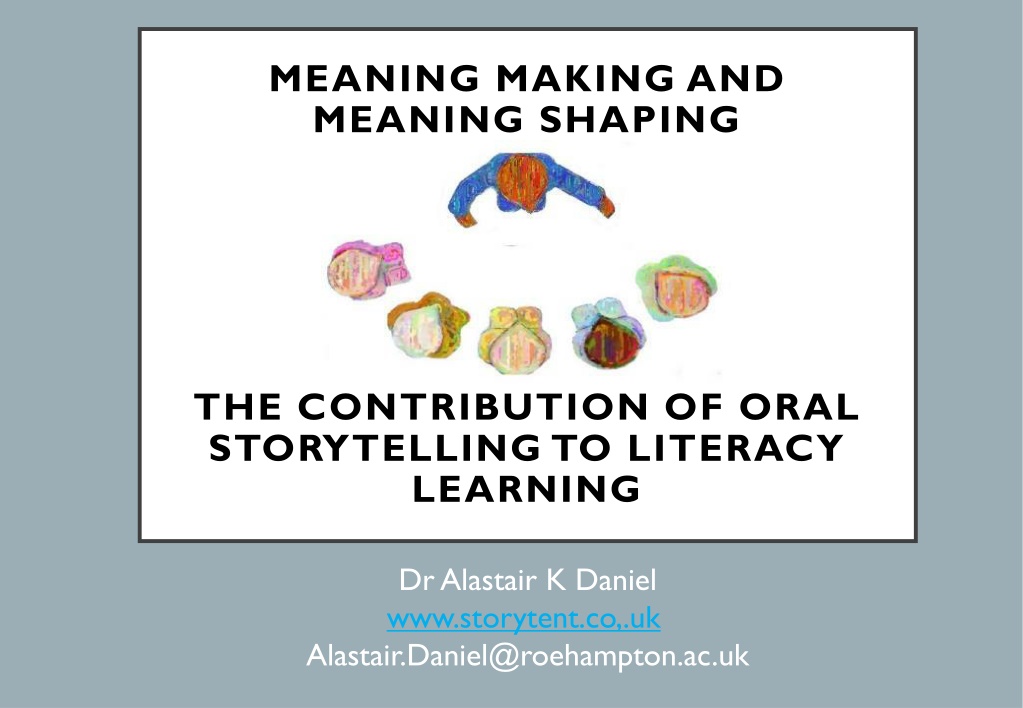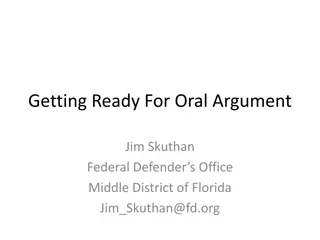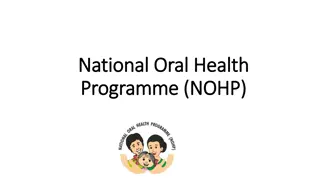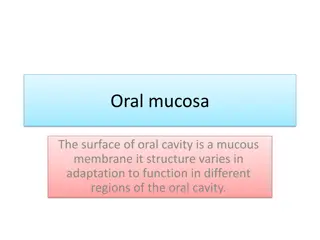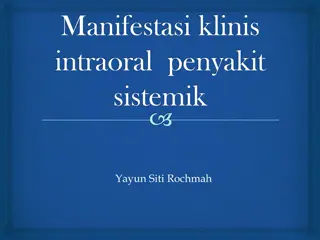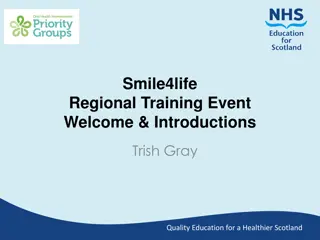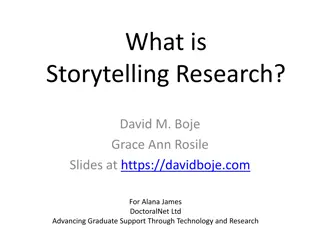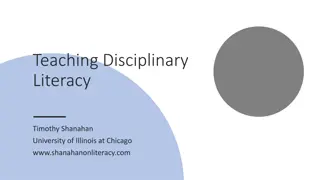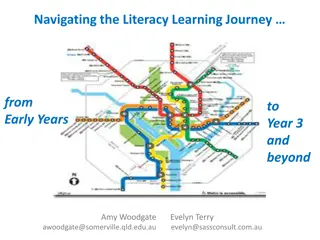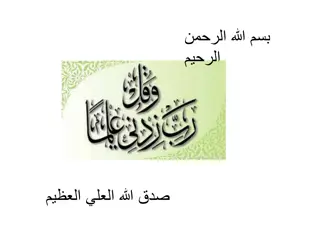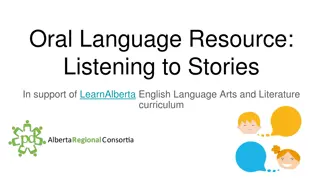Understanding the Role of Oral Storytelling in Literacy Learning
Oral storytelling plays a crucial role in literacy learning by allowing individuals to construct meaning through narratives. Dr. Alastair K. Daniel explores the significance of storytelling and its impact on interpreting events and ideas, emphasizing the blend of orality and literacy in education. Key questions delve into the nature of storytelling, its cultural implications, and its contribution to critical literacy skills. The resource encourages reflection on personal storytelling experiences and cultural influences while fostering a deeper understanding of storytelling practices.
Download Presentation

Please find below an Image/Link to download the presentation.
The content on the website is provided AS IS for your information and personal use only. It may not be sold, licensed, or shared on other websites without obtaining consent from the author. Download presentation by click this link. If you encounter any issues during the download, it is possible that the publisher has removed the file from their server.
E N D
Presentation Transcript
MEANING MAKING AND MEANING SHAPING THE CONTRIBUTION OF ORAL STORYTELLING TO LITERACY LEARNING Dr Alastair K Daniel www.storytent.co,.uk Alastair.Daniel@roehampton.ac.uk
AN OPENING WORD FROM GORDON WELLS stories have a role in education that goes far beyond their contribution to the acquisition of literacy. Constructing stories in the mind - or storying, as it is called - is one of the most fundamental means of making meaning (Bruner, 1986); as such, it is an activity that pervades all aspects of learning. When storytelling becomes overt and is given expression in words, the resulting stories are one of the most effective ways of making one's own interpretation of events and ideas available to others. Wells (2009) p214
KEY QUESTIONS What is storytelling, and do we need to differentiate it from story writing or story acting (or other artistic approaches to narrative such as choreography, film directing and painting)? Should storytelling be valued for its nature as oral expression or is its principle role to enhance literacy (with an emphasis on written text)? Is the celebration of oral culture the work of schools or, rather, that of wider society? Is there a specific set of storytelling skills that should be developed, or is storytelling, as an innate way of shaping meaning, a practice that we can simply rely upon as appropriate to the circumstances? Can a storytelling culture, and learning to tell stories, support learners in developing skills in critical literacy?
CONSTRUCTING A SEMANTIC FIELD FOR ORAL STORYTELLING
QUESTIONS TO CONSIDER Did the resource lead you to tell stories or talk about stories (what was the subject of your discourse, the actors in a story, or the story itself)? Did you identify common folk/fairy tale tropes or archetypes during your exploration of the resource? How culturally located were your explorations of the resources? What knowledge, skills or understanding did you bring to your exploration of the resource?
WHAT DO WE MEAN BY STORYTELLING? telling story reciting writing reading
WHAT DO WE MEAN BY STORYTELLING? telling performance sense-making With reference to Ochs and Capps (2001)
STORYTELLING: VARIATIONS IN PRACTICE Conversational storytelling A storyteller and a group of story hearers A principal storyteller in a storytelling community Group story recitation Group storytelling Interactive story-making (enacted) Directed story-making (enacted) https://www.youtube.com/watch?v=xvsLgrEDtyc
A MIDSUMMER NIGHT S DREAM: PLOT ACTIVITY 1 5 Print the cards (over), and ensure that the order is shuffled. Distribute the cards (one set per group). The children: arrange the cards in order check the order with an adult Group storytelling With the image cards as prompts, the children tell the story. The teller holds an object (such as a pen) to indicate who is acting as the storyteller. They pass the object between them. The aim is to recall as much as possible but keep the story flowing. Children should feel able to ask each other for help and refer to the character sheet as they wish. 2 6 Bottom and his friends meet to discuss their performance of Pyramus and Thisbe 3 7 4 8
FS/KS1: THE HELICOPTER TECHNIQUE BASED ON THE WORK OF VIVIAN GUSSIN PALEY (1990) TEACHER-DIRECTED STORY MAKING https://www.youtube.com/watch?v=UkJl8dyzRQQ&list= PLvtLx1SHcl4mwdHuTCJV7brL_L2PGbA2R&index=18
GODLY (AND NOT-SO-GODLY) PLAY playing with the language of God and God's people - sacred stories, parables, liturgical action and silence. Hyde (2010) p507 https://youtu.be/iBgSHFGnSZI
KAMISHIBAI (JAPANESE PAPER THEATRE) https://www.youtube.com/watch?v=GlZty1TZMU4&t=239s&index=5&l ist=PLvtLx1SHcl4kccGUB7Yb2o1wt2GAmQYWh
KAMISHIBAI IN THE CLASSROOM https://youtu.be/oEId2SFRezY
KAMISHIBAI IN THE CLASSROOM: READING OR TELLING? I do not have the students write their stories down during the course of the workshop, because I believe that they continue to develop their stories as they are retelling them. McGowan (2010), p23
LINES OF ENQUIRY oracy and literacy social storytelling and literacy engagement cultural engagement critical literacy
WHY STORYTELLING? [Storytelling assists] children in expanding story comprehension, oral retelling, and recognizing the elements of a story. Isbell, R; Sobol, J; Lindauer, L and Lowrance , A (2004) The Effects of Storytelling and Story Reading on the Oral Language Complexity and Story Comprehension of Young Children in Early Childhood Education Journal, Vol. 32, No. 3 ...while both showed strong positive effect, storytelling was superior to story reading for student vocabulary development and for comprehension. Haven, Kendall (2007). Story Proof; Westport CT: Libraries Unlimited: 114
STORYTELLING TO WRITING FOUR MONTH INTERVENTION WITH YEAR 6 The results clearly show a significant difference between the participating and control populations. . Not all children showed any improvement in marks gained over the four-month study period but 60% of the participating population did whereas only 34% of the control population did. the storytelling intervention did have a significant impact on raising the standard of fiction writing outcomes. (Coleman, 1991: 12 and 14)
Peck, J. (1989) Using Storytelling to Promote Language and Literacy Development : In The Reading Teacher, Vol. 43, No. 2
LISTENING TO STORIES LITERACY BENEFITS THAT CHILDREN CAN GAIN FROM LISTENING TO ORAL STORYTELLING INCLUDE practice in visualization cognitive engagement critical thinking story sequencing. Agusto, 2016: 23
AN UNDER-RESEARCHED AREA Colquhous, C. (2018) All the better to hear you with: Tips, Theory and Proof for the Educatinal Benefits of Storytelling. In Willison, C. An Introduciton to Storytelling by Storytellers from Around the Wordl. Stroud: The History Press / The Society of Storytelling. pp98-110
ORACY AND LITERACY oracy and literacy social storytelling and literacy engagement cultural engagement critical literacy
SIMPLE DEVELOPMENTAL MODEL OF WRITING Text generation (word, sentence, paragraph level) Working memory Executive functions (conscious attention, planning, reviewing, revising, strategies for self-regulation) Transcription (handwriting, keyboarding and spelling) Adapted from Berninger, V., & Amtmann, D. (2003)
ORACY AND LITERACY: CONSIDER THE FOLLOWING QUOTES . ..the linking of spoken language to written aims and outcomes negatively affects both the process of oral storytelling as well as the quality of S&L practice more generally. . . A rebalancing of the books is required, and a central element of any agenda that desires to reposition oracy in the curriculum needs to also establish the importance of a drive for oral outcomes as an end-point. Oral expression can exist and mostly has existed without any writing at all, writing never without orality. Ong, W. (1988) p8 Hibbin (2016): 60
SOCIAL ENGAGEMENT (TOWARDS DIALOGIC STORYTELLING) oracy and literacy social storytelling and literacy engagement cultural engagement critical literacy
STORYTELLING AS CONVERSATION; STORYTELLING AS DIALOGUE [Storytelling is] a shared process, a primary cultural institution, the social art of language Gussin Paley, V. (1990) The boy who would be a helicopter: the uses of storytelling in the classroom Cambridge, Mass: Harvard University Press: 23
SHARED (CONVERSATIONAL) STORYTELLING Sense making Performance
INDIVIDUAL PERFORMANCE STORYTELLING
INDIVIDUAL PERFORMANCE STORYTELLING there is a circular communication: a dynamic interchange takes place between the performance and the audience. Whitmore, J. (1994) Directing Postmodern Theater University of Michegan Press p26
SHARED (CONVERSATIONAL) STORYTELLING Sense shaping and sense making Process oriented Co-construction
SHARED PERFORMANCE STORYTELLING Sense shaping by tellers Sense making by audience Performance oriented Co-construction
CULTURAL ENGAGEMENT oracy and literacy social storytelling and literacy engagement cultural engagement critical literacy
STORY AND CULTURE our lives in culture are more aptly described in easily modifiable story form than in an inflexible true-or-false logic of derivation from first principles. Stories, indeed, provide the most generative and the most preservative medium for both making the strange familiar, and for doing the reverse. Bruner, (2007) p6
STORY AND CULTURE We more often tell stories to forewarn than to instruct. And because of this, stories are a culture's coin and currency. For culture is, figuratively, the maker and enforcer of what is expected, but it also, paradoxically, compiles, even slyly treasures, transgressions. Its myths and its folktales, its dramas and its pageants memorialise both its norms and its notable violations of them. Bruner (2002) p13 If we are to understand the relation of storytelling to literacy, we must see the value and nature of narrative as a means by which human beings, everywhere, represent and structure their world. We not only thrive on stories; we also survive by telling and retelling them, as history, discovery and invention. Meek (1991) p103
CRITICAL LITERACY oracy and literacy social storytelling and literacy engagement cultural engagement critical literacy
EVERYONE IS A STORYTELLER We all recognize story it is an ancient, perhaps natural order of mind - primordial, having grown along with the development of human memory and of language itself. Story is a way of organizing language Livo, Norma J. and Rietz, Sandra A (1986) [drawing on Brian Sutton-Smith (1981) The Folkstories of Children.] Storytelling: Process and Practice. Littleton CO: Libraries Unlimited. p5
THE UBIQUITY OF STORY No matter how strict a case is argues - scientifically, philosophically, or legally - it will always be a story, an interpretation of some aspect of the world that is historically and culturally grounded and shaped by human personality. Fisher (1987) p49 In the end... the narrative and the paradigmatic come to live side by side. Bruner, J (1986) p43 (a) inside every non-narrative kind of discourse there stalk the ghosts of narrative and (b) inside every narrative there stalk the ghosts of non-narrative discourse. There are always stories crying to be let out and meanings crying to be let in. Rosen (1987) p12
A FINAL WORD FROM GORDAN WELLS the reality each one of us inhabits is to a very great extent a distillation of the stories that we have shared: not only the narrative that we have heard and told, read, or seen enacted in drama or news on television, but also the anecdotes, explanations and conjunctures that are drawn upon in everyday conversation, in our perpetual attempts to understand the world in which we live and our experiences in it. Wells, G. (2009) p216-7
References: Agosto, D.E. (2016) Why storytelling matters: unveiling the literacy benefits of storytelling. In Children and Libraries Vol. 14 Issue 2, p21-26 Berninger, V., & Amtmann, D. (2003). Preventing written expression disabilities through early and continuing assessment and intervention for handwriting and/or spelling problems: Research into practice. In H. Swanson, K. Harris, and S. Graham (Eds.) Handbook of Learning Disabilities (pp 323- 344). New York: The Guilford Press. Bruner, J. (2007) Cultivating the Possible Jerome Bruner (currently unpublished) Bruner, J. (2002) Making Stories: Law, Literature, Life. Cambridge MA: Harvard University Press Bruner, J (1986) Actual Minds, Possible Worlds. Cambridge Mass: Harvard University Press Colquhous, C. (2018) All the better to hear you with: Tips, Theory and Proof for the Educational Benefits of Storytelling. In Willison, C. An Introduction to Storytelling by Storytellers from Around the World. Stroud: The History Press / The Society of Storytelling. pp98-110 Coleman, W. (2001) Literacy through storytelling A CPR Success Zone Action Research Project, available at http://www.bravetales.co.uk/bt_pdf/literacy_storytelling.pdf (accessed 24/10/18) Daniel, A.K. (2011) Storytelling across the primary curriculum. Abingdon: Routledge Dockrell, J., Marshall, C. and Wyse, D. (2015) Talk for Writing : Evaluation report and Executive summary, London: Education Endowment Foundation, Fisher, W.R. (1987) Human communication as Narrative. Columbia: University of South Carolina Fox, C. (1993). At the Very Edge of the Forest: The influence of literature on Storytelling by Children. London: Cassell Freire, P. (1970). Pedagogy of the oppressed. New York Seabury. Greimas, A.J. (1987) 'Actants, Actors, and Figures in On Meaning: Selected Writing in Semiotic Theory, Translated from the French by P.J Perron and F.H. Collins. On meaning: selected writings in semiotic theory, Minneapolis: University of Minnesota Press, pp106-120 Haven, K. (2007) Story Proof; Westport CT: Libraries Unlimited Haworth A. (2001) The Re-Positioning of Oracy: A Millennium Project? In Cambridge Journal of Education, 31 (1): 11 23. Hibbin, R. (2016) Oral Storytelling, Speaking and Listening and the Hegemony of Literacy: Non-Instrumental Language Use and Transactional Talk in the Primary Hyde, B (2010) Godly Play Nourishing Children Spirituality: A Case Study. Religious Education: The official jouranl of the Religious Education System. 105:5, 504-518 Isbell, R; Sobol, J; Lindauer, L and Lowrance , A (2004) The Effects of Storytelling and Story Reading on the Oral Language Complexity and Story Comprehension of Young Children in Early Childhood Education Journal, Vol. 32, No. 3 Livo, Norma J. and Rietz, Sandra A (1986) Storytelling: Process and Practice. Littleton CO: Libraries Unlimited Matter Mandler, J (1984) Stories, Schemas and Scenes: Aspects of Schema Theory. Hillsdale NJ: Lawrence Erlbaum McGowan, T.M. (2010) The Kamishibai Classroom. Santa Barbara CA:Libraries Unlimited / ABC-CLIO Meek, M. (1991) On Being Literate. London: The Bodley Head Ochs, O. and Capps, L. (2001) Living Narrative: Creating Lives in Everyday Storytelling. Harvard University Press Ong, W. (1988) Orality and Literacy: The Technologizing of the Word. London: Methuen, 1982. Rpt. New York and London: Routledge Classroom, Changing English, 23:1, 52-64, Pratt, M.L. (1977) Toward a Speech Act Theory of Literary Discourse. Bloomington (IN): Indiana University Press Rosen, H (1987) Stories and Meanings (Sheffield, UK: NATE) Street, B. (1984) Literacy in Theory and Practice. Cambridge: Cambridge University Press Wells, G. (2009) The Meaning Makers: Learning to Talk and Talking to Learn (2nd edn.). Bristol: Multilingual Matters Whitmore, Jon (1994) Directing Postmodern Theater University of Michigan Press
oral written social individual ephemeral permanent rhetorical functional structure freedom performer initiator cohesion chaos audience participant dialogue monologue adaptability fixed form fantasy reality embodied absent multimodal single channel creative formulaic criticality trust passive active
